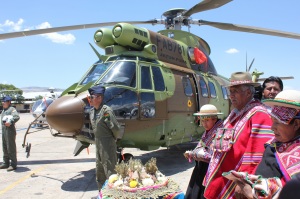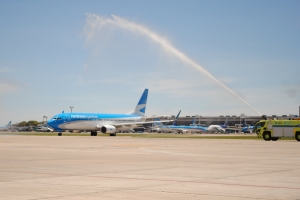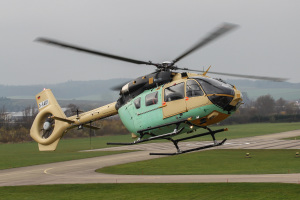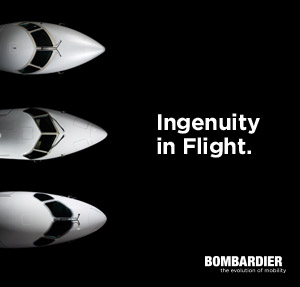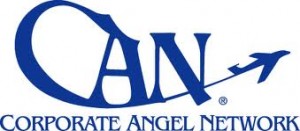Prosiguen trabajos en pista 17L del aeropuerto A. Merino B.
December 16, 2014
De acuerdo a lo programado prosiguen las obras de mantención del pavimento de la pista 17L del aeropuerto Arturo Merino Benítez, esperándose que la semana venidera se entregue una parte de la pista ya reparada, con un largo de 3100 mts., quedando para marzo su apertura con su largo total de 3800 mts.
Con ello las aeronaves podrán operar nuevamente con el sistema de aterrizajes por instrumentos categoría III B.
La Fuerza Aérea Boliviana recibe un segundo Super Puma de Airbus Helicopters
December 12, 2014
La Fuerza Aérea Boliviana recibe un segundo Super Puma de Airbus Helicopters
Bolivia, 12 de diciembre de 2014 – Airbus Helicopters ha entregado un segundo Super Puma AS332 C1e a la Fuerza Aérea Boliviana. La FAB adquirió a final de 2013, seis helicópteros de este modelo de categoría media-pesada para combatir el narcotráfico y para tareas de seguridad civil y de apoyo a la población a lo largo del país. El primero helicóptero fue entregado en agosto de este mismo año y los cuatro helicópteros pendientes serán entregados de aquí al 2016.
La ceremonia oficial de entrega tuvo lugar en Cochabamba, en presencia del Presidente del Estado Plurinacional de Bolivia, Señor Evo Morales Ayma y del Alto Mando de la Fuerza Aérea, así como del Embajador de Francia en Bolivia, Señor Michel Pinard y de personal de Airbus Helicopters.
El contrato de adquisición de los helicópteros Super Puma incluía también un paquete logístico de apoyo con el objetivo de dotar a la FAB con los medios y conocimientos necesarios para garantizar una alta disponibilidad de su flota de helicópteros. En este contexto y desde la llegada del primer Super Puma el pasado verano, la FAB cuenta con la presencia permanente de un experto técnico, así como con el soporte de un piloto instructor y de un instructor de mantenimiento para garantizar el éxito de la entrada en operación de los nuevos helicópteros. El espíritu de cooperación entre los dos países queda asimismo de manifiesto en el programa de transferencia tecnológica que contribuye al desarrollo de la cultura aeronáutica en Bolivia y mediante el cual se han formado más de 100 pilotos y técnicos de la FAB.
La larga relación de confianza entre Airbus Helicopters y la Fuerza Aérea Boliviana data de los años 70 con los helicópteros Lama y Alouette. En 2009 éstos fueron reemplazados por el Ecureuil AS350 B3, un helicóptero que destaca por su capacidad de operar en altitud y con temperaturas elevadas y que ha demostrado su polivalencia en misiones tan exigentes y diversas como el tendido de 4.000 metros de cable para el teleférico de La Paz o el Rally Dakar.
En 2012, la FAB incorporó dos helicópteros EC145 de Airbus Helicopters y otros dos en 2014, elevando la flota de este potente bimotor a 4, todos ellos dedicados al transporte de autoridades y a misiones de apoyo en caso de desastres naturales o emergencias. Los EC145 ya han podido demostrar su potencia, versatilidad y fiabilidad en las operaciones de rescate que siguieron a las inundaciones que a principios de año asolaron la parte oriental del país así como en las misiones de transporte de personalidades durante la cumbre del G77 que tuvo lugar en junio en la ciudad boliviana de Santa Cruz.
La familia Super Puma se adapta especialmente bien a las operaciones en América Latina, donde actualmente hay más de 110 helicópteros en operación y más de 50 nuevos pedidos en curso. Su capacidad para operar tanto en altura como en ambientes de selva, y temperaturas extremas le permite superar sin problemas los desafíos operativos de la región, en particular de la Cordillera de los Andes y del altiplano, con condiciones particulares de altura y temperatura.
Rápido, potente, fiable y seguro, el Super Puma de Airbus Helicopters, con más de 4,75 millones de horas de vuelo en todo el mundo, se ha convertido en la referencia indiscutible en su categoría y está presente en casi todos los países de América Latina. Perfecto para misiones que van desde el transporte táctico, apoyo a la población, vigilancia, evacuación sanitaria o lucha anti-droga. La
Press Release
Page 2 of 2
adaptabilidad y polivalencia de este aparato, capaz de ser rápidamente configurado para diferentes misiones, es una de las grandes ventajas de este helicóptero que ya se ha ganado la confianza de 94 clientes en 48 países.
ALTA Member Airlines Passenger Traffic Increases 4.8% in October
December 11, 2014
Miami, December 10, 2014- The Latin American and Caribbean Air Transport Association (ALTA) announced that its member airlines carried 15.4 million passengers in October, up 4.8% from the previous year.
Traffic (RPK) grew 4.9% and capacity (ASK) increased 2.5%, bringing up the load factor to 80.4%, 1.9 percentage points higher than in October 2013.
The number of passengers carried year-to-date increased 5.3% versus the same period of the previous year, reaching 147.4 million passengers. During the aforementioned period, traffic (RPK) rose 5.6%, capacity (ASK) increased 2.5%, and the passenger load factor reached 79.6%, 2.3 percentage points higher than the previous year.
Freight ton kilometers increased 4.4% in October but declined 0.5% year-to-date.
SuperJet International is the Award Winner of the Global Transport Finance (GTF) 2014
December 10, 2014
London – December 10, 2014
On December 8, 2014 SuperJet International (SJI) – joint venture between Finmeccanica-Alenia Aermacchi and Sukhoi Holding – received a special award from the Global Transport Finance in recognition of the most innovative financing transaction and the best contribution to the aviation transport finance industry in 2014.
SuperJet International was awarded on the occasion of the prestigious GTF Annual Award at the historic Merchant Taylors’ Hall in London.
Namely, the SJI transaction was recognised as the “Aircraft Debt Deal of the Year for Latin America” and the Company was also awarded as the “Aircraft Finance Innovator of the Year”.
SuperJet International, with the collaboration of Sukhoi Civil Aircraft Company, developed a noteworthy financing package for the Sukhoi Superjet 100 aircraft (SSJ100) through a multilateral export credit guaranteed by Coface, SACE and EXIAR.
With the support of the Export Credit Agencies of three Countries – France, Italy and Russia – and the active cooperation with four banks – Natixis, Deutsch Bank, Intesa San Paolo and VEB – SuperJet International offered to its customer Interjet (Mexico) an outstanding long-term financing for the purchase of the SSJ100 aircraft.
The Mexican airline Interjet ordered 20 SSJ100 aircraft. Up to date eleven SSJ100 have been delivered and financed through this multilateral export credit.
“We are very proud of this outstanding recognition from Global Transport Finance – states Nazario Cauceglia, CEO of SuperJet International – it confirms that we are offering not only a super optimized 100-seat aircraft with advanced technology, but we are also capable to propose innovative and attractive financing solutions to our customers.
To date 40 Sukhoi Superjet 100 aircraft have been delivered. The entire fleet logged more than 68.000 flight hours worldwide, with excellent results in terms of dispatch reliability.
LAN takes delivery of first A321
December 5, 2014
LAN Airlines, part of LATAM Airlines Group celebrated the arrival of its first A321 today at Santiago’s Comodoro Arturo Merino Benítez International Airport. This marks a significant milestone as LATAM Airlines affirms its regional and global presence as the largest A320 operator in Latin America. The aircraft, the first of 48 of its kind ordered by the airline, will be operated on domestic routes within Chile and joins LATAM Group’s existing fleet of nearly 230 A320 Family aircraft in operation.
The A321 aircraft ordered by LAN have a one-class configuration with 220 seats and feature a new LATAM Airlines Group’s cabin, which is a blend of LAN and TAM cabin designs.
The A320 family’s largest member offers the lowest fuel burn, emissions and noise footprint in its class, and allows for an extended operating range of up to 3,200 nautical miles while carrying a maximum passenger payload; all of which will enhance the efficiency of LAN’s operations within Chile
The A320 Family is Latin America’s and the world’s best-selling single aisle product line with nearly 11,000 orders to date and more than 6,200 aircraft delivered to 400 customers and operators worldwide. Today more than 500 A320 Family aircraft are operated by airlines in Latin America.
Airbus Group and Safran Launch Joint Venture
December 3, 2014
· New Company With Initial Workforce of 450 Will be Named Airbus Safran Launchers
· Transaction Reaffirms Companies’ Determination to Boost Competitiveness and
Ensure Profitability of European Space Launcher Business
· ESA Approval of Industrial Ariane 6 Proposal Confirms the Relevance of the Joint
Venture
Amsterdam / Paris, 3 December 2014 – Airbus Group (stock exchange symbol: AIR) and Safran
(stock exchange symbol: SAF) have announced the creation of their new Joint Venture named Airbus
Safran Launchers.
With an initial workforce of around 450, starting operations on 1 January 2015, Airbus Safran
Launchers will maintain the outstanding level of quality and reliability of Ariane 5, while working on
a new family of state-of-the-art space launchers to foster Europe’s leading role in the space industry.
The new company will bring together the expertise of both Airbus Group and Safran in space
launchers at key Franco-German industrial sites. The Joint Venture’s headquarters will be located in
Issy-les-Moulineaux, near Paris.
This first transaction follows the announcement in June 2014 by Airbus Group and Safran regarding
their intention to pool their respective space launcher activities to boost competitiveness and ensure
the profitability of the European space launcher business in the face of growing international
competition.
Airbus Group and Safran welcome yesterday’s approval by the European Space Agency’s (ESA)
Ministerial Conference for the development and production of a new Ariane 6 space launcher.
Both companies have made a far-reaching industrial proposal for Ariane 6 and its endorsement was
critical for the Joint Venture’s creation. The industry proposal naturally assumes an in-principle
agreement for the transfer to the JV of shares in Arianespace held by the Centre National d’Etudes
Spatiales, France’s space agency.
“With this Joint Venture, industry has made a strong statement and has assumed leadership to foster
Europe’s autonomous access to space. Yesterday’s ESA Ministerial Conference will be remembered
as the one that decided upon a new Ariane launcher family for the next decades and opened a new
chapter in the way Europe conducts and manages its space ambitions. If we want to successfully
counter growing international competition and prevent the risk of Europe’s space sector from being
marginalized, a lot more has to be done. Therefore, we hope that this ESA Ministerial Conference
serves as a catalyst to transform the way institutional space agencies operate and interface with
industry in the future,” said Tom Enders, Chief Executive Officer of Airbus Group.
“The creation of Airbus Safran Launchers immediately after the Ministerial Conference is much more
than a symbol, it is a sign of our strong engagement and our ability to deploy our resources and meet
our commitments. This is precisely what we will continue to do to ensure that all stakeholders –
industry and European States – are able to pursue the remarkable success of the Ariane programme
and continue to guarantee independent, reliable and competitive access to space for Europe.
I strongly believe Airbus Safran Launchers will be a major worldwide player in the launcher domain,
poised to capture market growth and better serve institutional as well as commercial customers.
Indeed, Europe has all it needs to be in a pole position in the race for technologies, which will be, as in
the past, highly beneficial for the whole aerospace industry,” said Jean-Paul Herteman, Chairman and
Chief Executive Officer of Safran.
Enders and Herteman also thanked the teams at Airbus Group and Safran who over the last months
have prepared the establishment of the new company in record time. With the support of customers
and shareholders, most regulatory approvals and consultations such as those from the competition
authorities, Arianespace and the two Groups’ Works Councils have been completed for the
transaction. Closing is expected on 31 December 2014 after completion of final formalities.
This signature launches the first, initial phase of the transaction. In a second phase, all activities of
Airbus Group and Safran dealing with space launchers will be integrated in the Joint Venture.
Russian Helicopters start delivering new batch of Mi-171Sh to Peru
December 3, 2014
Moscow / 03 December 2014
Russian Helicopters (part of State Corporation Rostec) has delivered the first batch of four Mi-171Sh military transport helicopters, made by Ulan-Ude Aviation Plant, to the Ministry of Defence of Peru. The Mi-171Sh are being delivered to Peru a month ahead of schedule. The customer also received aviation equipment required for its operation in addition to the helicopters.
The helicopters were supplied under a contract concluded with Rosoboronexport, Russian Helicopters’ partner in the export of military products. This contract was the largest to be concluded in the recent history of military and technical cooperation with Peru and was one of the largest in the global market for military transport helicopters.
Under the contract concluded in December 2013, 24 helicopters will be supplied to Peru: eight in 2014, with the rest to follow in 2015. A maintenance centre for Russian Helicopters will also be established in Peru, which will make it possible to keep the country’s helicopter fleet in a constant state of operational readiness, and to use them effectively in counter-narcotics and counter-terrorism operations.
The Mi-171Sh helicopters and aviation equipment were delivered to Peru by an An-124 ‘Ruslan’ transport plane, and were handed over to the Armed Forces’ Army Aviation brigade. On 9 December they are due to take part in celebrations to mark Army Day in Peru. It is anticipated that by then, all four helicopters will have undergone final acceptance testing, on the basis of which the Ministry of Defence committee should sign the acceptance document and approve the equipment for Army use.
The Mi-171Sh multirole military transport helicopters supplied under contract are equipped with the latest systems boosting their combat efficiency, providing comprehensive protection of their main systems and crew from attack, and avionics suites that enable them to fly in adverse weather conditions and at any time of day or night.
The helicopters can carry up to 26 paratroopers. They are equipped with two sliding doors and electro-hydraulic ramp, making a full ground-troop landing possible within just 7-8 seconds. As the customer requested, the helicopters are painted in Peru Army colours.
Peru’s Armed Forces already operate Russian helicopters. In July 2010, Peru’s Armed Forces purchased eight Russian helicopters (six military-transport Mi-171Sh and two attack Mi-35P), and delivery on these orders was completed in October 2011. In total, since the 1970s, about 100 Soviet and Russian-made helicopters have been delivered to Peru, where the army has for a long time already been operating Russian Mi-8/17 and Mi-24/35 type helicopters.
Operators rate Russian-made helicopters very highly, noting their outstanding flight capabilities, high reliability, ease of operation and maintenance, and the fact that they can be operated in adverse conditions. The armed forces of many different countries value the universality of Mi-8/17 type helicopters, which have proved themselves in numerous local conflicts, in counter-terror operations and police assignments. Mi-8/17 helicopters have demonstrated their superior performance and efficiency in disaster response work following floods and earthquakes, and other natural and man-made disasters, in search and rescue operations and in evacuating those affected.
AEROLINEAS ARGENTINAS INCORPORO UN NUEVO BOEING 737/800 A SU FLOTA
December 1, 2014
�
�
�
�
�
�
�
�
�
�
Aerolíneas Argentinas presentó un nuevo Boeing 737/800 para su flota de cabotaje y regional, siendo la décima aeronave recibida directamente desde la fábrica Boeing, en Seattle, con la que el parque de estas aeronaves suma catorce unidades.
Al recibir la nueva unidad el Presidente de Aerolíneas Argentinas, Mariano Recalde, afirmó: “hoy Aerolíneas cuenta con 69 aviones operativos, lo que marca una diferencia fundamental con los 26 que nos encontramos en el 2008 y pone de manifiesto la tarea que el Estado, por indicación de la presidenta Cristina Fernández de Kirchner está llevando adelante”.
El B-737/800 – matriculado LV-FUC – forma parte del programa de modernización y ampliación de flota que Aerolíneas Argentinas instrumentó a partir de la estatización de la línea de bandera.
La flota de aeronaves de fuselaje angosto de Aerolíneas Argentinas cuenta hoy con 14 B-737/800 y 22 B-737/700 NG, lo que permite seguir desarrollando el Plan de Negocios que tendrá su continuación con la incorporación de otros tres B-737/800 en 2015 y con la compra de otros veinte B-737/800, nuevos de fábrica, que serán entregados, según la orden de adquisición firmada en octubre de este año con la Compañía Boeing, entre 2016 y 2018. El beneficio de incrementar la flota con Boeing 737/800 está dado porqué estas aeronaves se pueden configurar con mayor cantidad de asientos y esto significa un menor costo operativo.
El B-737/800 tiene 170 plazas con 162 butacas en turista y 8 en Economy Plus, y el interior de su cabina está diseñado de acuerdo a las especificaciones de Boeing Sky Interior, para ofrecer mayor confort y comodidad a los pasajeros.
Por otra parte y en la presentación del B-737/800 de Aerolíneas Argentinas la Administración Nacional de Aviación Civil (ANAC) habilitó la aeronave con un nuevo Certificado de Matricula.
Para evitar que los Certificados de Matrícula y de Aeronavegabilidad puedan ser falsificados, la Dirección de Aeronavegabilidad dependiente de la Dirección Nacional de Seguridad Operacional de la Administración Nacional de Aviación Civil, implementó un programa de Seguridad Documental para ajustar dichos Certificados a los niveles más exigentes de seguridad disponibles en nuestro país, los cuales serán impresos en el nuevo papel que fuera adquirido a la Casa de la Moneda.
El nuevo documento habilitante de aeronaves cuenta con medidas de seguridad tales como: Marca de agua, filigrana; guilloche; fondo de seguridad; microletras; numeración de hojas y código de barras.
Successful First Flight of Airbus Helicopters’ EC645 T2
December 1, 2014
�
�
�
�
�
�
�
�
�
�
Bundeswehr to receive the first helicopters in this series in late 2015
Donauwörth, November 27, 2014 – Airbus Helicopters’ newest lightweight military multi-role helicopter, the EC645 T2 (LUH SOF), has successfully completed its first flight. In the presence of representatives of the German Armed Forces (Bundeswehr), which has ordered the first of this new helicopter type, the EC645 T2 demonstrated its capacities at the company’s Donauwörth location in Bavaria.
“This first flight is a milestone in the EC645 T2 program and we’re thrilled to be able to celebrate this event with our customer,” said Ralf Barnscheidt, Head of the German Military Support Center. “We’re right on schedule to deliver the first EC645 T2 helicopters in the coming year. This is also a product of the close-knit collaboration between the Airbus Helicopters and Bundeswehr project teams.”
The EC645 T2 is the military version of the civil EC145 T2 that entered into service this past summer. With a maximum takeoff weight of 3.7 tons, the EC645 T2 can be used for a wide range of military operations including transportation, reconnaissance, search and rescue, fire support, and evacuations of wounded personnel. The Bundeswehr has ordered 15 of these helicopters for the German Air Force. The EC645 T2 represents a significant addition to the German Air Force’s capabilities and offers a host of features that make it particularly well suited to missions carried out by the Special Forces Command (KSK).
Building on the robustness, low operating costs and the especially high operational availability of the EC145 family, the new EC645 T2 is equipped with the Helionix® digital avionics suite, including the 4-axis autopilot developed by Airbus Helicopters. This aircraft has been optimized for day and night missions as well as for those carried out in treacherous weather conditions. Its mission equipment range also includes a fast roping system for troops, cargo hooks, hoists, various weapons and electro-optical sensors. Ballistic protective equipment and an electronic countermeasures system that detects threats help protect the helicopter and crew. Powered by two Turbomeca Arriel 2E engines, the EC645 T2 is equipped with full authority digital engine control (FADEC). What’s more, noise emissions significantly below international limits make the EC645 T2 the quietest helicopter in its class.
The military version of the EC145 has proven its worth to customers around the world. For instance, the US Armed Forces operates more than 300 of this helicopter type, which Airbus Helicopters delivered on time and on budget. These aircraft achieve an operational availability of over 90 percent on average. The Royal Thai Armed Forces recently also ordered five EC645 T2 helicopters.
Airbus Group Sells Part of Its Stake in Dassault Aviation
December 1, 2014
Sells To Dassault Aviation 810,072 Shares In Off-Market Block Trade for € 980 per Share
Transaction Reduces Airbus Group Stake in Dassault Aviation from 46 to 42 Percent
Attempts Further Sale of Up to 10 Percent by 30 June 2015, Subject to Market Conditions
Amsterdam, 28 November 2014 – Airbus Group (stock exchange symbol: AIR) in an off-market block trade has sold to Dassault Aviation a total of 810,072 Dassault Aviation shares at a price of € 980 per share, representing a total amount of around € 794 million pre transaction costs.
The French State has agreed to waive its rights under the shareholder agreement with Airbus Group, which provides in particular a right of first offer to its benefit, for this block trade, which represents approximately 8 percent of Dassault Aviation’s share capital.
After this transaction, Airbus Group will hold 38.32 percent of Dassault Aviation’s share capital and associated voting rights and then following the cancellation by Dassault Aviation of 9 percent of treasury shares, Airbus Group will own 42.11 percent of the Dassault shares with associated voting rights. In this context, Airbus Group will solicit from the Autorité des marchés financiers (AMF) an exemption to the requirement to launch a public offer.
Further to today’s block trade, Airbus Group has provided a best efforts commitment until 30 June 2015 to sell up to 10 percent of Dassault Aviation’s share capital, subject to market conditions. This additional transaction should take place in the form of an accelerated book-building through either one or several placements. Airbus Group will have the ability to increase the size of the placements beyond this 10 percent of Dassault Aviation’s share capital.
Dassault Aviation has committed to support the implementation of these efforts and will place an order on 50 percent of the size of such placements, within a global limit of 5 percent of Dassault Aviation’s share capital, at a maximum price of € 980 per share. Airbus Group has committed to serve Dassault Aviation with 50 percent of the shares sold and within the same global limit of 5 percent of Dassault Aviation’s share capital, at the price of the relevant placement. Should the placement price be higher than € 980, the price of the Dassault Aviation shares sold at the same time to Dassault Aviation would be capped thereat while the price of the shares sold to third parties would remain the same.
“This transaction marks an important step in our stated intentions to monetise our stake in Dassault Aviation. Furthermore, we have retained market and timing flexibility, together with support from Dassault Aviation, that should allow us to optimise further monetisation steps during 2015,” said Marwan Lahoud, Airbus Group Chief Strategy and Marketing Officer.


